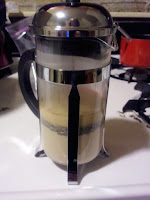 |
| Chill your glass.. |
You'll want to use just the liquid from the cranberry sauce to ensure the flavor is modified in the correct proportion. For pomegranate liqueurs, PAMA or an aromatic pomegranate juice grenadine would both work well.
Shake all on ice. Double-strain into a chilled cocktail glass. Garnish with a lime wedge.
 |
| This sand's just gone all to my rear.. |
2 oz rye whiskey
1 oz Spicy Cosmopolitan Cranberry Sauce
1/2 oz pomegranate liqueur
1 dash Angostura bitters
lime wedge
But now then, if the cranberry sauce is any indication, we're going to invert the Cosmopolitan. This Sex in the City-beloved cocktail normally comes entirely out of bottles, so, that aspect gets chucked in favor of fresh ingredients -- albeit cooked ingredients combining the Cosmo's cranberry, citrus and lime. Also, flavor-packed rye whiskey, the mortal enemy of vodka in cocktailian circles and what you might get from vodka if it weren't so filtered, serves to invert the nature of this drink more. To round out this new mixture, since citrus flavors and acidity are already well-incorporated in the cranberry sauce, pomegranate liqueur balances the flavors just right.
Ok, so the feminine obsession with "super foods" doesn't entirely extricate this new drink from the old's gestalt, but it's what worked in this case.
3. Remove ginger coins (if applicable) and add orange liqueur, orange juice and bitters. Cook until combined and appropriately saucy in thickness.
2. Reduce to a simmer and add all but the orange liqueur, orange juice and bitters. Stir and cook until all the berries have burst and sauce has come together.
1. Heat the cranberries, water, and sweetener in a pot on high heat until the berries start to pop.
Spicy Cosmopolitan Cranberry Sauce
6 oz fresh or frozen cranberries (half a bag)
3/4 c. water
2 1/2 T agave nectar or sugar
finely grated zest from 1/3 lime and 1/8 orange
pulp of a lime wedge, sans pith
3-4 ginger root coins or 1/2 tsp powdered ginger
1/2 tsp allspice
1/4 tsp cloves
small pinch sea salt
2 T orange liqueur
2 T orange juice
2 dashes Angostura bitters
To start, let's have dinner! Let's not just make cranberry sauce, but a Cosmopolitan-flavored cranberry sauce, then load it up with lots of dark spices, just 'cause it's winter and tasty. Granted, this would be better in the aftermath of the holidays if you have an extra half a bag of cranberries, but if you have to pull them out of the freezer, that works too. This cranberry sauce is excellent on chicken or pork, natch.
Wow, Inversion is a serious challenge for thinking up something new on the spot. But...to invert my normal m.o., I think I might have an ace up my sleeve, and it's one I've been sitting on for a few Thanksgivings now. It all has to do with how, much like cachaça opposes cognac, rye is the opposite spirit to vodka. *rubs hands together* Follow along, will you?
When active, this link will send you to the summary post of this month's festivities.
A while ago, while researching Julia Child’s recipes, we noticed that she was well-known for enjoying “upside-down” or “inverted” Martinis. This is a version of the classic cocktail that swaps the ratios of gin and vermouth, turning the Martini into something of a “long drink”… We wondered if we could apply the same “inverted” approach to Mixology Monday and, at first, didn’t think it would work. But then we asked ourselves, what does “inverted” really mean? Well, here is the definition, “To turn inside out or upside down; to reverse the position, order, or condition of.” Hmm…it appears that the definition is pretty broad. It seems that “inverted” really just means something “flipped on its head”. And that can mean almost anything, and leaves plenty of room for creativity… You can invert the ratios of spirits, liqueurs or bitters in a cocktail, but we suggest you go beyond that and “invert” whatever you want. Spirits, name, ingredients, proof, color, geography, garnish and glassware are all fair game. An apéritif made with Navy-Strength booze? Give it a try. A beer-based cocktail that tastes like champagne? Sure. A clear Manhattan? Worth a shot (and good luck with that). The only thing we expect is the unexpected. Have fun.

Our host for this month's Mixology Monday: the Renaissance folks behind food, drinks and gorgeous photography at Putney Farm. Our theme: Inverted Cocktails:
Let's get ready to MxMooooooooooooo!!!!!!!!









